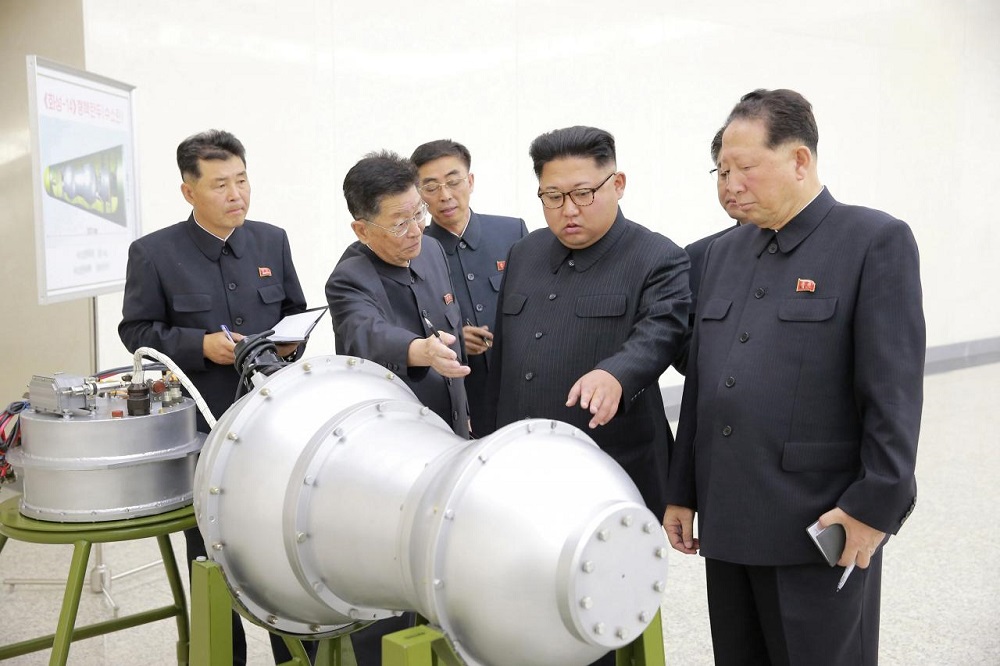North Korea announced on Sunday that it successfully tested a hydrogen bomb, in a new step towards its goal to achieve nuclear power and signifying an escalation in its standoff with world powers over its ambitions.
North Korea said in an announcement on state television that a hydrogen bomb test ordered by leader Kim Jong Un was a “perfect success” and a “meaningful” step in completing the country’s nuclear weapons programs.
The bomb was designed to be mounted on its newly developed intercontinental ballistic missile (ICBM) the North said in the announcement, which came hours after the US Geological Survey (USGS) reported a 6.3 magnitude quake.
Japan and South Korea earlier detected a shallow earthquake in North Korea, which turned out to be its H-bomb test. They said that the quake was around 10 times more powerful than previous detonations, and concluded the North had conducted its sixth nuclear test.
There was no independent confirmation that the detonation was a hydrogen bomb.
It was the North’s first nuclear test since US President Donald Trump took office, and marked a direct challenge to Trump, who hours earlier had talked by phone with Japanese Prime Minister Shinzo Abe about the “escalating” nuclear crisis in the region.
A US official who studies North Korea’s military and politics said it was too early to determine if a test supported the North’s claim that has succeeded in developing a thermonuclear weapon, “much less one that could be mounted on an ICBM and re-enter Earth’s atmosphere without burning up”.
Japan immediately raised the prospect of further sanctions against the isolated North, with Chief Cabinet Secretary Yoshihide Suga saying that curbs on its oil trade would be on the table.
Under third-generation leader Kim, North Korea has been pursuing a nuclear device small and light enough to fit on a long-range ballistic missile, without affecting its range and making it capable of surviving re-entry into the Earth’s atmosphere.
South Korea’s military said the first earthquake “appeared to be manmade”. A meeting of Seoul’s National Security Council has been convened, national news agency Yonhap reported.
South Korea’s presidential office said the security chiefs for Seoul and Washington have spoken following North Korea’s sixth nuclear test.
The office says US National Security Adviser H.R. McMaster spoke with his South Korean counterpart, Chung Eui-yong, for 20 minutes in an emergency phone call about an hour after the detonation.
Earthquakes triggered by North Korean nuclear tests have gradually increased in magnitude since Pyongyang’s first test in 2006, indicating the isolated country is steadily improving the destructive power of its nuclear technology.
A hydrogen bomb can achieve thousands of kilotons of explosive yield – massively more powerful than some 10 to 15 kilotons that North Korea’s last nuclear test in September was estimated to have produced, similar to the bomb dropped on Hiroshima, Japan, in 1945.
Kim Jong Un, who visited the country’s nuclear weapons institute, “watched an H-bomb to be loaded into new ICBM” and “set forth tasks to be fulfilled in the research into nukes,” KCNA said.
Pictures released by the agency showed Kim inspecting a silver-colored, hourglass-shaped warhead in the visit accompanied by nuclear scientists.
The North said in its statement Sunday that its H-bomb “is a multi-functional thermonuclear nuke with great destructive power which can be detonated even at high altitudes for super-powerful EMP (electromagnetic pulse) attack according to strategic goals.”
Kim claimed that “all components of the H-bomb were homemade … thus enabling the country to produce powerful nuclear weapons as many as it wants.”
In what could be read as a veiled warning of more nuclear tests, Kim underlined the need for scientists to “dynamically conduct the campaign for successfully concluding the final-stage research and development for perfecting the state nuclear force” and “set forth tasks to be fulfilled in the research into nukes.”
Tensions on the Korean peninsula have been high since last month when North Korea threatened to launch missiles into the sea near the strategically located US Pacific territory of Guam after Trump said Pyongyang would face “fire and fury” if it threatened the United States.
North Korea further raised regional tensions on Tuesday by launching an intermediate-range ballistic missile over Japan, drawing international condemnation.
Trump and Abe spoke by phone and said that in face of an “escalating” situation with North Korea that close cooperation between their countries and with South Korea was needed, Abe told reporters.
The United States has repeatedly urged China, the North’s sole major ally, to do more to rein in its neighbor.
Impoverished North Korea and the rich, democratic South are technically still at war because their 1950-53 conflict ended in a truce, not a peace treaty. The North regularly threatens to destroy the South and its main ally, the United States.
